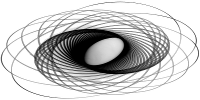Sophie Schirmer, Frank Langbein, Edmond Jonckheere. Control of Quantum Spin Devices, feedback control laws and hidden feedback. Principles and Applications of Control in Quantum Systems, 11th Workshop, PRACQSYS 2017.
Networks of interacting spin-1/2 particles form the basis for a wide range of quantum technologies including quantum communication, simulation and computation devices. Optimal control provides methods to steer their dynamics to implement specific quantum operations. It is usually implemented to find optimal time-dependent control fields to implement quantum gates or transformations of quantum states or observables in the context of open-loop quantum control.
We recently proposed an alternative approach of static controls, based on shaping the energy landscape of quantum systems. For coupled spin systems this type of control could be realized in terms of spatially distributed gates that introduce energy level shifts using quasi-static local electric or magnetic fields. Although there are insufficient control degrees of freedom for the system to be completely controllable, many practically interesting operations can be implemented using these controls, including efficient transfer of excitations in spin networks. Furthermore, the resulting controllers combine high fidelity and strong robustness properties under device uncertainties, surpassing traditional limits in classical control. In particular, we observe positive correlations between the logarithmic sensitivity and the control error in many cases, i.e., the highest fidelity controllers are also the most robust. Structured singular value analysis shows the same trend for large structured variation using μ-analysis tools.
One way to understand the surprising robustness of the controllers is in terms of feedback control laws. The energy biases create direct feedback loops. Similar to feedback loops in electronic circuits such as operational amplifiers, this feedback is highly effective and does not require measurements.
I will discuss results on energy landscape control for quantum spin devices with a focus on robustness at high fidelities of the operations and the interpretation of the controllers in terms of feedback control laws.
References
[1] Emergence of Classicality under decoherence in robust quantum transport, S. Schirmer, E. Jonckheere, S. O’Neil, and F. Langbein, in preparation.
[2] Design of Feedback Control Laws for Information Transfer in Spintronics Networks, S Schirmer, E Jonckheere, F Langbein, arXiv:1607.05294, 2016.
[3] Time optimal information transfer in spintronics networks, FC Langbein, S Schirmer, E Jonckheere, 2015 IEEE 54th Annual Conference on Decision and Control (CDC), 6454-58, 5, 2015.
[4] Structured singular value analysis for spintronics network information transfer control, E Jonckheere, S Schirmer, F Langbein, IEEE Transactions on Automatic Control, DOI: 10.109/TAC.2017.2714623, arXiv:1706.03247, in press, 2017.
[5] Jonckheere-Terpstra test for nonclassical error versus log-sensitivity relationship of quantum spin network controllers, E Jonckheere, S Schirmer, F Langbein, rXiv:1612.02784, 2016.
[6] Information transfer fidelity in spin networks and ring-based quantum routers, E Jonckheere, F Langbein, S Schirmer, Quantum Information Processing 14 (12), 4751-4785.
[7] Multi-fractal Geometry of Finite Networks of Spins, P Bogdan, E Jonckheere, S Schirmer, arXiv:1608.08192, 2016.
![]() This work is licensed under a Creative Commons Attribution-NonCommercial-ShareAlike 4.0 International License.
This work is licensed under a Creative Commons Attribution-NonCommercial-ShareAlike 4.0 International License.
